Hongcheng Gao
Kimi K2: Open Agentic Intelligence
Jul 28, 2025Abstract:We introduce Kimi K2, a Mixture-of-Experts (MoE) large language model with 32 billion activated parameters and 1 trillion total parameters. We propose the MuonClip optimizer, which improves upon Muon with a novel QK-clip technique to address training instability while enjoying the advanced token efficiency of Muon. Based on MuonClip, K2 was pre-trained on 15.5 trillion tokens with zero loss spike. During post-training, K2 undergoes a multi-stage post-training process, highlighted by a large-scale agentic data synthesis pipeline and a joint reinforcement learning (RL) stage, where the model improves its capabilities through interactions with real and synthetic environments. Kimi K2 achieves state-of-the-art performance among open-source non-thinking models, with strengths in agentic capabilities. Notably, K2 obtains 66.1 on Tau2-Bench, 76.5 on ACEBench (En), 65.8 on SWE-Bench Verified, and 47.3 on SWE-Bench Multilingual -- surpassing most open and closed-sourced baselines in non-thinking settings. It also exhibits strong capabilities in coding, mathematics, and reasoning tasks, with a score of 53.7 on LiveCodeBench v6, 49.5 on AIME 2025, 75.1 on GPQA-Diamond, and 27.1 on OJBench, all without extended thinking. These results position Kimi K2 as one of the most capable open-source large language models to date, particularly in software engineering and agentic tasks. We release our base and post-trained model checkpoints to facilitate future research and applications of agentic intelligence.
Representation Entanglement for Generation:Training Diffusion Transformers Is Much Easier Than You Think
Jul 02, 2025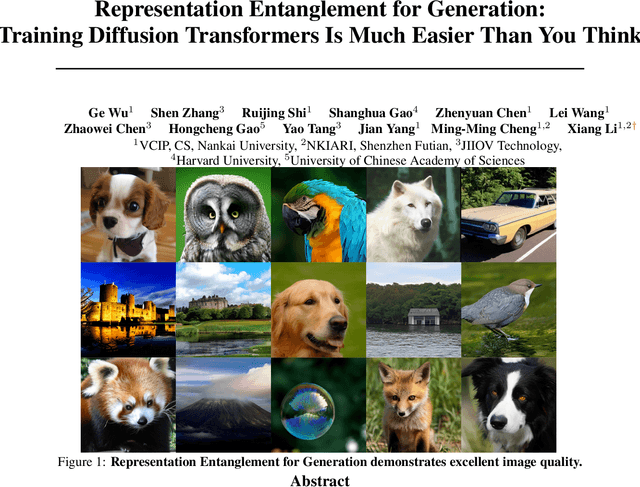
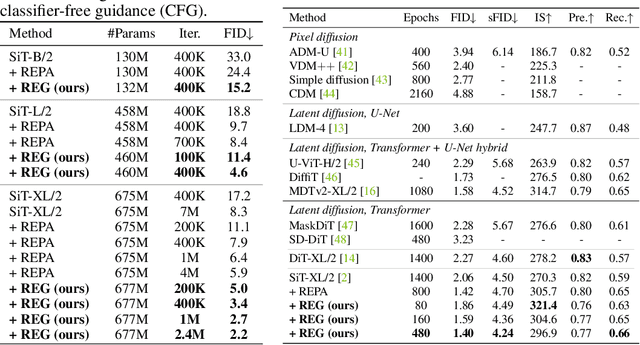
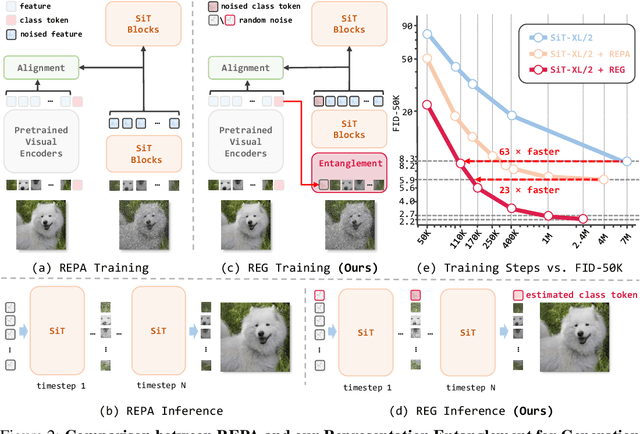
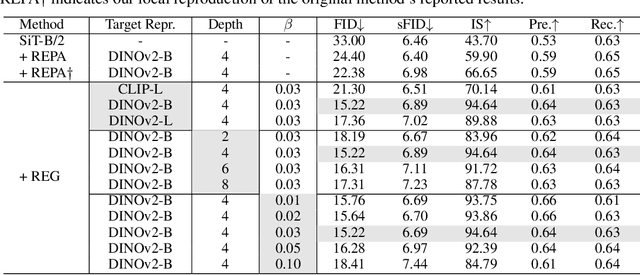
Abstract:REPA and its variants effectively mitigate training challenges in diffusion models by incorporating external visual representations from pretrained models, through alignment between the noisy hidden projections of denoising networks and foundational clean image representations. We argue that the external alignment, which is absent during the entire denoising inference process, falls short of fully harnessing the potential of discriminative representations. In this work, we propose a straightforward method called Representation Entanglement for Generation (REG), which entangles low-level image latents with a single high-level class token from pretrained foundation models for denoising. REG acquires the capability to produce coherent image-class pairs directly from pure noise, substantially improving both generation quality and training efficiency. This is accomplished with negligible additional inference overhead, requiring only one single additional token for denoising (<0.5\% increase in FLOPs and latency). The inference process concurrently reconstructs both image latents and their corresponding global semantics, where the acquired semantic knowledge actively guides and enhances the image generation process. On ImageNet 256$\times$256, SiT-XL/2 + REG demonstrates remarkable convergence acceleration, achieving $\textbf{63}\times$ and $\textbf{23}\times$ faster training than SiT-XL/2 and SiT-XL/2 + REPA, respectively. More impressively, SiT-L/2 + REG trained for merely 400K iterations outperforms SiT-XL/2 + REPA trained for 4M iterations ($\textbf{10}\times$ longer). Code is available at: https://github.com/Martinser/REG.
G1: Bootstrapping Perception and Reasoning Abilities of Vision-Language Model via Reinforcement Learning
May 19, 2025Abstract:Vision-Language Models (VLMs) excel in many direct multimodal tasks but struggle to translate this prowess into effective decision-making within interactive, visually rich environments like games. This ``knowing-doing'' gap significantly limits their potential as autonomous agents, as leading VLMs often performing badly in simple games. To address this, we introduce VLM-Gym, a curated reinforcement learning (RL) environment featuring diverse visual games with unified interfaces and adjustable, compositional difficulty, specifically designed for scalable multi-game parallel training. Leveraging VLM-Gym, we train G0 models using pure RL-driven self-evolution, which demonstrate emergent perception and reasoning patterns. To further mitigate challenges arising from game diversity, we develop G1 models. G1 incorporates a perception-enhanced cold start prior to RL fine-tuning. Our resulting G1 models consistently surpass their teacher across all games and outperform leading proprietary models like Claude-3.7-Sonnet-Thinking. Systematic analysis reveals an intriguing finding: perception and reasoning abilities mutually bootstrap each other throughout the RL training process. Source code including VLM-Gym and RL training are released at https://github.com/chenllliang/G1 to foster future research in advancing VLMs as capable interactive agents.
GuardReasoner-VL: Safeguarding VLMs via Reinforced Reasoning
May 16, 2025Abstract:To enhance the safety of VLMs, this paper introduces a novel reasoning-based VLM guard model dubbed GuardReasoner-VL. The core idea is to incentivize the guard model to deliberatively reason before making moderation decisions via online RL. First, we construct GuardReasoner-VLTrain, a reasoning corpus with 123K samples and 631K reasoning steps, spanning text, image, and text-image inputs. Then, based on it, we cold-start our model's reasoning ability via SFT. In addition, we further enhance reasoning regarding moderation through online RL. Concretely, to enhance diversity and difficulty of samples, we conduct rejection sampling followed by data augmentation via the proposed safety-aware data concatenation. Besides, we use a dynamic clipping parameter to encourage exploration in early stages and exploitation in later stages. To balance performance and token efficiency, we design a length-aware safety reward that integrates accuracy, format, and token cost. Extensive experiments demonstrate the superiority of our model. Remarkably, it surpasses the runner-up by 19.27% F1 score on average. We release data, code, and models (3B/7B) of GuardReasoner-VL at https://github.com/yueliu1999/GuardReasoner-VL/
FlowReasoner: Reinforcing Query-Level Meta-Agents
Apr 21, 2025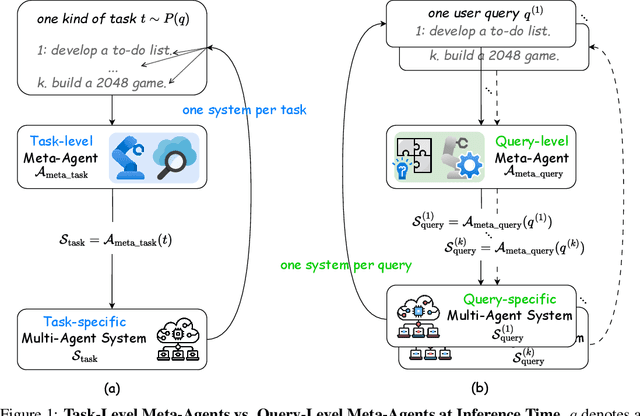
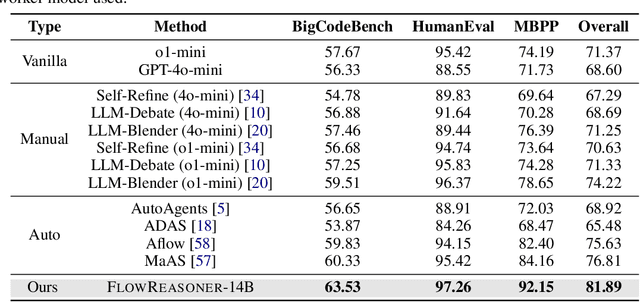
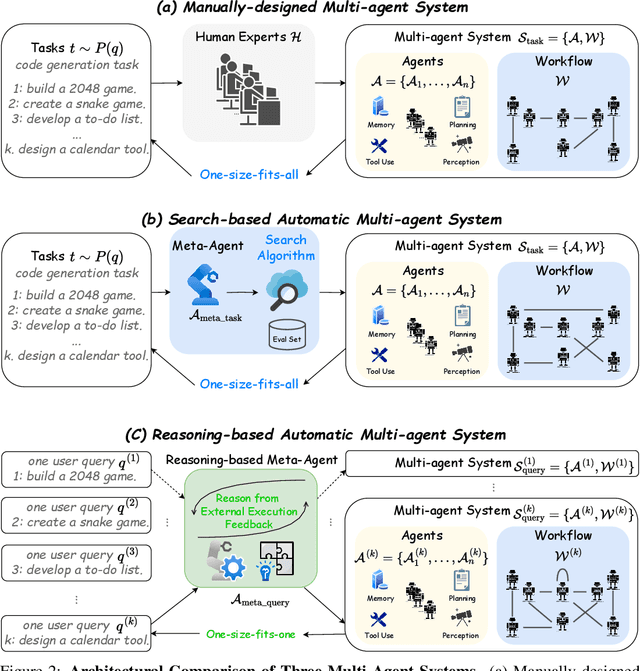

Abstract:This paper proposes a query-level meta-agent named FlowReasoner to automate the design of query-level multi-agent systems, i.e., one system per user query. Our core idea is to incentivize a reasoning-based meta-agent via external execution feedback. Concretely, by distilling DeepSeek R1, we first endow the basic reasoning ability regarding the generation of multi-agent systems to FlowReasoner. Then, we further enhance it via reinforcement learning (RL) with external execution feedback. A multi-purpose reward is designed to guide the RL training from aspects of performance, complexity, and efficiency. In this manner, FlowReasoner is enabled to generate a personalized multi-agent system for each user query via deliberative reasoning. Experiments on both engineering and competition code benchmarks demonstrate the superiority of FlowReasoner. Remarkably, it surpasses o1-mini by 10.52% accuracy across three benchmarks. The code is available at https://github.com/sail-sg/FlowReasoner.
Kimi-VL Technical Report
Apr 10, 2025

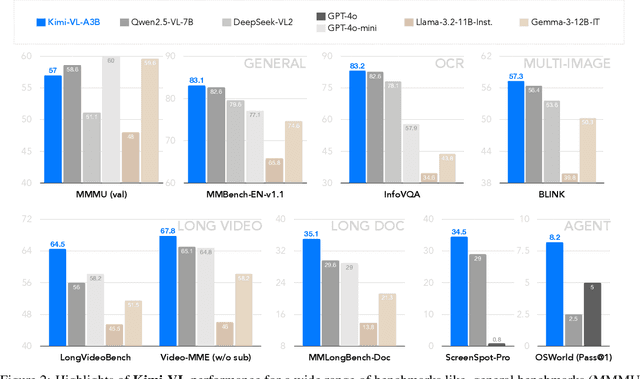

Abstract:We present Kimi-VL, an efficient open-source Mixture-of-Experts (MoE) vision-language model (VLM) that offers advanced multimodal reasoning, long-context understanding, and strong agent capabilities - all while activating only 2.8B parameters in its language decoder (Kimi-VL-A3B). Kimi-VL demonstrates strong performance across challenging domains: as a general-purpose VLM, Kimi-VL excels in multi-turn agent tasks (e.g., OSWorld), matching flagship models. Furthermore, it exhibits remarkable capabilities across diverse challenging vision language tasks, including college-level image and video comprehension, OCR, mathematical reasoning, and multi-image understanding. In comparative evaluations, it effectively competes with cutting-edge efficient VLMs such as GPT-4o-mini, Qwen2.5-VL-7B, and Gemma-3-12B-IT, while surpassing GPT-4o in several key domains. Kimi-VL also advances in processing long contexts and perceiving clearly. With a 128K extended context window, Kimi-VL can process diverse long inputs, achieving impressive scores of 64.5 on LongVideoBench and 35.1 on MMLongBench-Doc. Its native-resolution vision encoder, MoonViT, further allows it to see and understand ultra-high-resolution visual inputs, achieving 83.2 on InfoVQA and 34.5 on ScreenSpot-Pro, while maintaining lower computational cost for common tasks. Building upon Kimi-VL, we introduce an advanced long-thinking variant: Kimi-VL-Thinking. Developed through long chain-of-thought (CoT) supervised fine-tuning (SFT) and reinforcement learning (RL), this model exhibits strong long-horizon reasoning capabilities. It achieves scores of 61.7 on MMMU, 36.8 on MathVision, and 71.3 on MathVista while maintaining the compact 2.8B activated LLM parameters, setting a new standard for efficient multimodal thinking models. Code and models are publicly accessible at https://github.com/MoonshotAI/Kimi-VL.
Efficient Inference for Large Reasoning Models: A Survey
Mar 29, 2025
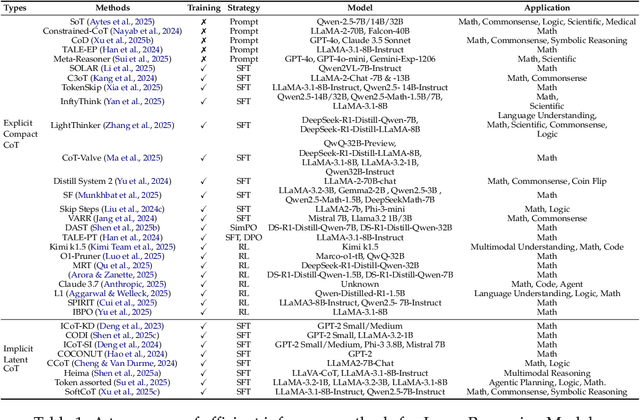
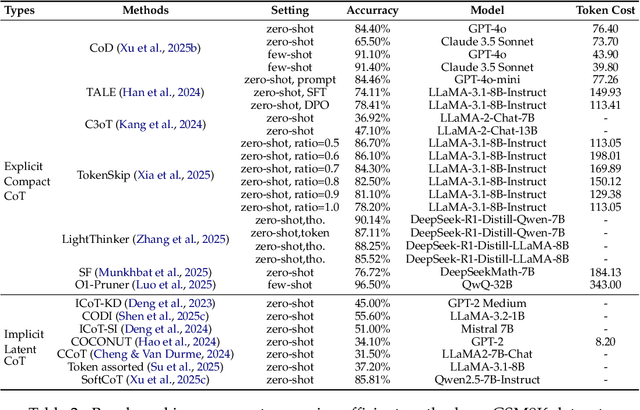
Abstract:Large Reasoning Models (LRMs) significantly improve the reasoning ability of Large Language Models (LLMs) by learning to reason, exhibiting promising performance in complex task-solving. However, their deliberative reasoning process leads to inefficiencies in token usage, memory consumption, and inference time. Thus, this survey provides a review of efficient inference methods designed specifically for LRMs, focusing on mitigating token inefficiency while preserving the reasoning quality. First, we introduce a taxonomy to group the recent methods into two main categories: (a) explicit compact Chain-of-Thought (CoT), which reduces tokens while keeping the explicit reasoning structure, and (b) implicit latent CoT, which encodes reasoning steps within hidden representations instead of explicit tokens. Meanwhile, we discuss their strengths and weaknesses. Then, we conduct empirical analyses on existing methods from performance and efficiency aspects. Besides, we present open challenges in this field, including human-centric controllable reasoning, trade-off between interpretability and efficiency of reasoning, ensuring safety of efficient reasoning, and broader applications of efficient reasoning. In addition, we highlight key insights for enhancing LRMs' inference efficiency via techniques such as model merging, new architectures, and agent routers. We hope this work serves as a valuable guide, helping researchers overcome challenges in this vibrant field\footnote{https://github.com/yueliu1999/Awesome-Efficient-Inference-for-LRMs}.
Exploring Hallucination of Large Multimodal Models in Video Understanding: Benchmark, Analysis and Mitigation
Mar 25, 2025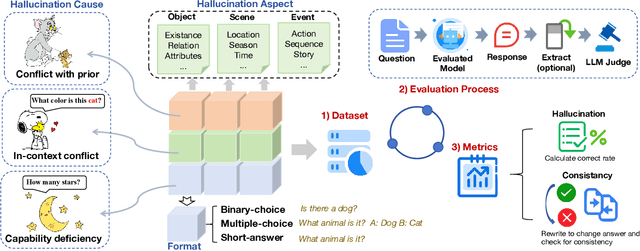
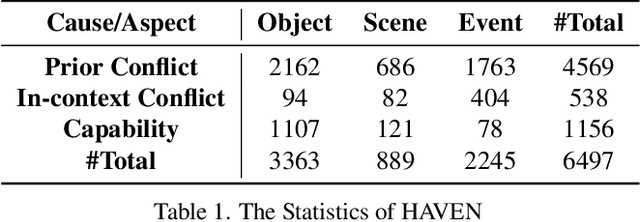

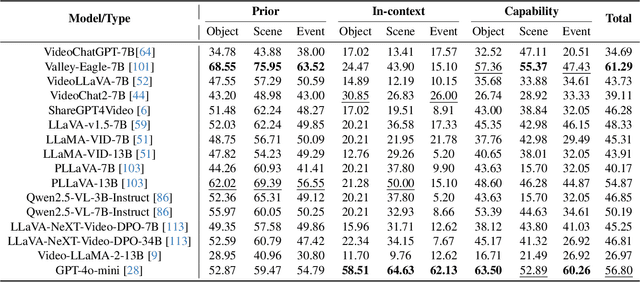
Abstract:The hallucination of large multimodal models (LMMs), providing responses that appear correct but are actually incorrect, limits their reliability and applicability. This paper aims to study the hallucination problem of LMMs in video modality, which is dynamic and more challenging compared to static modalities like images and text. From this motivation, we first present a comprehensive benchmark termed HAVEN for evaluating hallucinations of LMMs in video understanding tasks. It is built upon three dimensions, i.e., hallucination causes, hallucination aspects, and question formats, resulting in 6K questions. Then, we quantitatively study 7 influential factors on hallucinations, e.g., duration time of videos, model sizes, and model reasoning, via experiments of 16 LMMs on the presented benchmark. In addition, inspired by recent thinking models like OpenAI o1, we propose a video-thinking model to mitigate the hallucinations of LMMs via supervised reasoning fine-tuning (SRFT) and direct preference optimization (TDPO)-- where SRFT enhances reasoning capabilities while TDPO reduces hallucinations in the thinking process. Extensive experiments and analyses demonstrate the effectiveness. Remarkably, it improves the baseline by 7.65% in accuracy on hallucination evaluation and reduces the bias score by 4.5%. The code and data are public at https://github.com/Hongcheng-Gao/HAVEN.
LanP: Rethinking the Impact of Language Priors in Large Vision-Language Models
Feb 17, 2025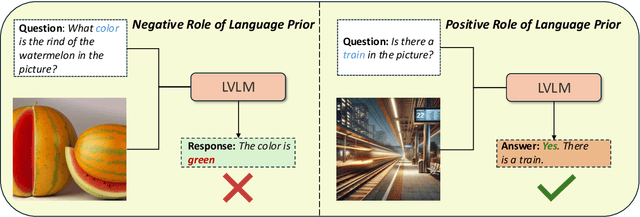
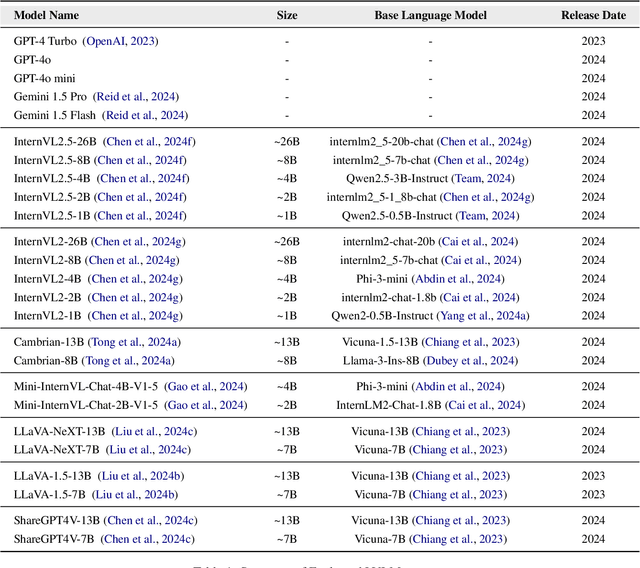
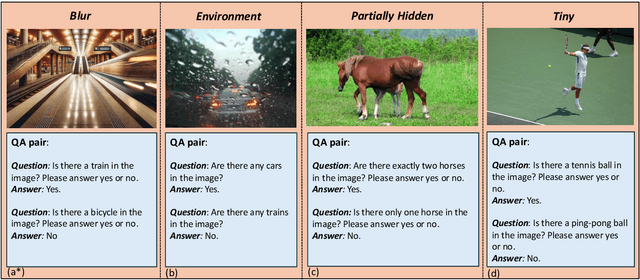
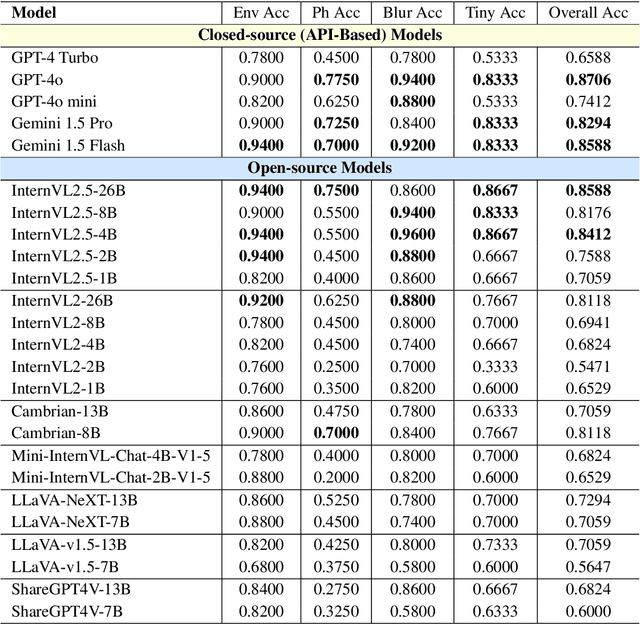
Abstract:Large Vision-Language Models (LVLMs) have shown impressive performance in various tasks. However, LVLMs suffer from hallucination, which hinders their adoption in the real world. Existing studies emphasized that the strong language priors of LVLMs can overpower visual information, causing hallucinations. However, the positive role of language priors is the key to a powerful LVLM. If the language priors are too weak, LVLMs will struggle to leverage rich parameter knowledge and instruction understanding abilities to complete tasks in challenging visual scenarios where visual information alone is insufficient. Therefore, we propose a benchmark called LanP to rethink the impact of Language Priors in LVLMs. It is designed to investigate how strong language priors are in current LVLMs. LanP consists of 170 images and 340 corresponding well-designed questions. Extensive experiments on 25 popular LVLMs reveal that many LVLMs' language priors are not strong enough to effectively aid question answering when objects are partially hidden. Many models, including GPT-4 Turbo, exhibit an accuracy below 0.5 in such a scenario.
GuardReasoner: Towards Reasoning-based LLM Safeguards
Jan 30, 2025



Abstract:As LLMs increasingly impact safety-critical applications, ensuring their safety using guardrails remains a key challenge. This paper proposes GuardReasoner, a new safeguard for LLMs, by guiding the guard model to learn to reason. Concretely, we first create the GuardReasonerTrain dataset, which consists of 127K samples with 460K detailed reasoning steps. Then, we introduce reasoning SFT to unlock the reasoning capability of guard models. In addition, we present hard sample DPO to further strengthen their reasoning ability. In this manner, GuardReasoner achieves better performance, explainability, and generalizability. Extensive experiments and analyses on 13 benchmarks of 3 guardrail tasks demonstrate its superiority. Remarkably, GuardReasoner 8B surpasses GPT-4o+CoT by 5.74% and LLaMA Guard 3 8B by 20.84% F1 score on average. We release the training data, code, and models with different scales (1B, 3B, 8B) of GuardReasoner : https://github.com/yueliu1999/GuardReasoner/.
 Add to Chrome
Add to Chrome Add to Firefox
Add to Firefox Add to Edge
Add to Edge